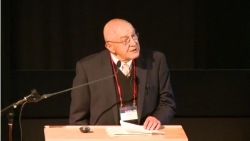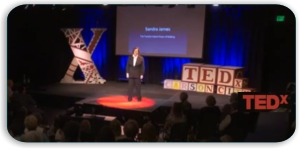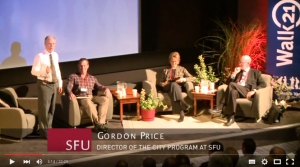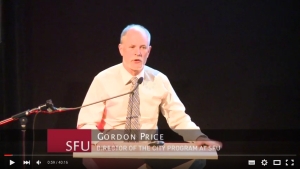An august group of planners in Sydney Australia, London England, Paris and Vancouver are looking at “intersection signal intervals” -how long it takes for the walk signal to activate after a pedestrian pushes the cross walk button. This group feels that the livability of a city and the quality of the walking environment can be measured on the length of time that pedestrians are given to walk across the street. It’s been fascinating to see how varied those interval times are in cities around the world.
As always, the Dutch are early adapters to the changes in technology necessary to make walkability safer for all ages. The Dutch city of Tilburg has been testing a smartphone application that allows seniors and those with restricted mobility more crossing time at intersections. The app has four time settings which are adjusted dependent on the user’s mobility to minimise traffic delay. While a sensor in the traffic lights scan the sidewalk adjacent to the intersection, it looks for a signal from the app to adjust crossing time.
As reported in The Guardian “Dynniq, the Dutch company that develops intelligent traffic systems and is helping the city council with the trial, explains the app works in combination with GPS and the software that operates the traffic lights, so there is no need to install extra devices. The company is also developing a spin-off for cyclists, the CrossCycle, which will sense when bikes are approaching a junction and change the lights sooner. Another version detects visually impaired pedestrians and activates the ticking sounds that tell them whether the light is red or green.”
While the app can respond to individual users, the app can also adjust for a group of school children, so that the app will keep the crossing green for the children until a teacher confirms that they are safely across. While this initial pilot has only ten users, it is part of a pilot to enhance safety and comfort for pedestrians and cyclists. “We want to do more with smart mobility and use technology rather than just putting down more asphalt,” says Mark Clijsen, urban planning specialist at the city council.”

Category Archives: Uncategorized
Walking in Central Park, the High Line and Brooklyn Park with Mitchell Silver and Julie Crimson
I spent a week in New York City where I spent time wallking with Mitchell Silver the Park Commissioner for New York City, and Julie Grimson, City Conversations Manager for the City of Sydney Australia. Mitchell is a renown city planner who was the planning director for the City of Raleigh and was formerly the head of the American Planning Association. He has a wonderful office in the historic Arsenal in Central Park. Robert Moses’ old office adjacent to Mitchell’s is now the board room for staff meetings.

Famed City Master Builder Robert Moses in his office in the Arsenal, Central Park, 1940’s

Mitchell Silver and Julie Grimson in what was Robert Moses’ “closet” in the Arsenal
One of the prime drivers of public space in New York City in Central Park and on the High Line has been the creation of conservancies or public “trusts” that bring in massive donations and bequests to fund the maintenance and improvement of public space. As Christopher Nolan who is the Chief Landscape Architect for Central Park notes, the challenge was incentivizing public space as something that people would leave money to, and to have people see it as important as endowing a building. Today 75 per cent of the funding for Central Parks’s 65 million dollar annual budget comes directly from the conservancy. The conservancy also undertakes all the basic care in the 845 acre park.

Chris Nolan, Chief Landscape Architect, Central Park Conservancy
The same approach in forming a conservancy has been taken by the “Friends of the High Line” originally formed by Joshua David and Robert Hammond. This group raised over 150 million dollars in private and public funds. The High Line was an old abandoned elevated train track that connected several warehouse buildings in the old meatpacking district. Today with an annual operating budget of $11.5 million, the Friends of the High Line maintain and run the daily operations at a cost of $5 million dollars a year.
The High Line is a surprise-it is an elevated wonderland of plants in a pastiche carefully designed and placed by master plantsman Piet Oudolf. The plants themselves are in soil that is only 16 inches deep. There are elevators that go up to the High Line for disabled access, and many volunteers gardening and counting plants along its 2.33 kilometer length. There is an amphitheatre, a water feature for children to play in, lots of public art discoveries, and plenty of people enjoying it. It is already one of the top attractions of things to do in New York City, with over seven million annual visits. Locals plan their own visits to the High Line around “peak times” on this elevated greenway. As Mitchell Silver notes, the amount of pedestrian traffic suggests that the walkway should have been wider. Cyclists and skateboarders are banned, and there are refreshment locations, benches, and lots of good people watching.

Mitchell Silver describes the High Line as the incubator for the rejuvenation and revitalization of the meatpacking district. The Google Corporation purchased the former Port Authority Building, a massive fifteen story building in this area in 2010 for their headquarters. The Google building has 2.9 million square feet (the size of two Tsawwassen Mills Malls) in its interior. There is now a hotel and the new Whitney Museum of American Art abutting the High Line. There is no doubt that the renewal of this elevated space has instigated new interest in the area.
Public Art installation on High Line by British Columbia Artist Sascha Braunig

NYC Park Commissioner Mitchell Silver, Julie Grimson, City of Sydney Australia, and Robert Hammond, Founder of the High Line. Robert is also one of the producers of “Citizen Jane”, the acclaimed documentary on Jane Jacobs.
Alex Washburn who was the Chief Urban Designer for New York City used to say candidly that if projects could be implemented in New York City with the tangle and complexity of public interests and municipal by-laws, that those projects could be considered in any other North American place too. And maybe with the experience of the New York City High Line and the new High Line like project in Seoul Korea called “Seoullo 7017” (which is reusing an old 1970’s elevated highway as a greenway to make the city more pedestrian friendly) we should be rethinking the potential use of the Vancouver Georgia Viaducts.
Perhaps reusing and readapting these urban engineering artifacts is a way to creatively rebirth new people places. New York has proven that their conservancy model works, not only in traditional landscaped parks, but in elevated engineering remnants of another urban age.
Walking, Transit and the Trash~The New York City Demonstration Project
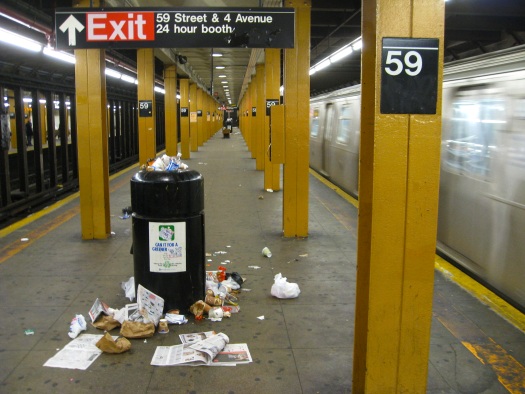
For anyone that walks around major cities, garbage is a problem. There never seems to be a garbage bin in the right place at the right time. And that was the case in this New York City story.
Global news describes the end of a demonstration project in New York City that installed garbage bins at subway stations. Commenced in 2011, the program expanded to have garbage containers at track level in 39 stations. The problem? The program was too successful. While the whole point was to reduce littering in subway stations, the city found that having the containers contributed to more litter, and to rats.
Of course reducing rubbish bins sounds wrong. “Thenotion that you’re going to be more efficient by taking away the trash cans, so therefore you won’t generate so many bags of trash to haul away — like the trash was going to magically disappear — I think that probably wasn’t the smartest judgment,” quoted State Comptroller Tom DiNapoli.” Indeed New York City found that the containers led to a higher incidence in trash fires, and depositing of trash on the tracks. And to get rid of trash on tracks? New York City has a “vacuum train”.
The anticipated solution is that everyone will carry their trash out of the station and properly deposit it on the street. With the majority of commuters in New York City used to disposable conveniences, they are used to carrying everything in their hands or buying on the go. On city streets there are lots of trash cans, just not below the ground.
To give you an idea of the size of the subway system, it has 469 stations and moves about 1.76 billion people annually.

The Magic of Messing it Up: Making Automobile Streets More Walkable
A salon with Allan Jacobs, author Great Streets, Consultant in city planning and urban design
and Mary Beth Rondeau, Senior Urban Designer at City of Surrey
TEDx: The Transformative Power of Walking
I was so excited to be asked to speak in Carson City Nevada. It was a different experience, memorizing your talk and speaking on a television set with five cameras. The event was sold out, and there was an overflow theatre that accommodated an additional four hundred people. I came away inspired by the many aspects of community that were talked about, and honored to meet a group of people, all from different “walks” of life that truly believe in creating the very best community to live in. For me, the Transformative Power of Walking describes why I believe promoting walking in neighborhoods and communities is the right thing to do.
TED which stands for technology, entertainment and design is a series of conferences where invited speakers talk about their area expertise on a common theme. I was invited to speak at TEDx in Carson City Nevada on the theme of “Creating the Community You Want to Live In”.
The Arts, Entertainment and Speaker Line up was diverse and interesting,( http://www.tedxcarsoncity.com/2016-speakers) including a New York City performance artist, a new classical music composition, puppetry, and a wide variety of outstanding speakers. The talks included ones on Sibling Advocacy for Autism, Surviving Cancer, Dealing with Discomfort by a famous outdoors photographer, and a talk about growing up in the foster system and finding life purpose. My talk, The Transformative Power of Walking” also fit into the theme of community building.
All of the talks are delivered in one day to a live audience and there are five cameras that live stream the videos. It was an extraordinary day to participate and learn.
Carson City is the capital city of Nevada, located at the junction of two major rivers. The downtown had been bisected by a state highway for years. This highway is now being diverted off the main street, and the town is building bike lanes, sidewalks and other pedestrian amenities to allow citizens to use the downtown as pedestrians after decades of highway dominance. My talk outlines why enhancing walking’s bottom line is good for everyone-citizens, business people and the community.
Sandy James
Data show that distracted walking is a non-issue and isn’t growing
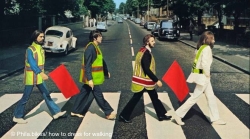 From Treehugger: “I have been writing a lot lately about various campaigns to stop distracted walking, to ban texting and walking, and to even stop walking and talking as a distraction. Invariably, I am deluged in comments about how walking and texting while crossing a street is dumb and dangerous, and doing it on the sidewalk is rude and slows people down. I have also been criticized for my complaints about dressing pedestrians up in dayglo like the Beatles up above. I don’t think I have done a very good job of explaining my concerns, and will try again here. It starts with the reasons used to justify these campaigns.” Read more at Treehugger
From Treehugger: “I have been writing a lot lately about various campaigns to stop distracted walking, to ban texting and walking, and to even stop walking and talking as a distraction. Invariably, I am deluged in comments about how walking and texting while crossing a street is dumb and dangerous, and doing it on the sidewalk is rude and slows people down. I have also been criticized for my complaints about dressing pedestrians up in dayglo like the Beatles up above. I don’t think I have done a very good job of explaining my concerns, and will try again here. It starts with the reasons used to justify these campaigns.” Read more at Treehugger
The Pedestrian Portfolio – Economic Development, Public Art, Walkers and Wealth
Panel Discussion, moderated by Gordon Price, Director, The City Program, Simon Fraser University; Panel Members: Chris Vollan, Vice President, Development, Rize Alliance; Cynthia Melosky, Vice President, Development, Polygon Homes Ltd; Michael Geller, President, The Geller Group
Janette Sadik-Khan in Vancouver: Shaking up the status quo
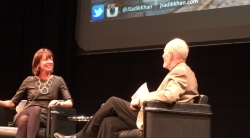 Janette Sadik-Khan came to Vancouver on March 24 with publicist Seth Solomonow to promote her new book “Streetfight”, a Handbook for an urban evolution. Janette is now working with Bloomberg Associates and bringing her strong urban placemaking skills to cities around the world. http://www.jsadikkhan.com/streetfight-the-book.html
Janette Sadik-Khan came to Vancouver on March 24 with publicist Seth Solomonow to promote her new book “Streetfight”, a Handbook for an urban evolution. Janette is now working with Bloomberg Associates and bringing her strong urban placemaking skills to cities around the world. http://www.jsadikkhan.com/streetfight-the-book.html
Sadik-Khan was the Transportation Commissioner for New York City from 2007 to 2013. She has a law degree from Columbia University and had a staff of 4,500 people with the New York City Department of Transportation. She is also a person that lets her staff do the right work instead of doing the work right. I had the chance to do some work with her staff in the Department of Transportation in 2009.
Sadik-Khan’s success in implementing new pedestrian spaces and installing protected bike lanes came about from her strategy of “trying things out”, doing demonstration projects in place on the streets, vowing to remove the projects if they were not successful. The projects were successful and they stayed.
With over 30,000 deaths in U.S. car accidents a year on 2.5 million miles of road, Sadik-Khan states that this kind of carnage would not be acceptable in any other profession. She describes the Manual on Uniform Traffic Control Devices as the “best clip art”. By using the devices contained in the manual, Engineers stay within the established parameters for road building and for their profession.
I have written an article on Price Tags about this noting that transportation engineers do not have to answer directly for crashes and accidents due to their street design. Staying with standardization there is no new innovation that can be learned and designed for a specific space. As long as transportation engineers stay within accepted national standards, they cannot be directly sued. The article is here: https://pricetags.wordpress.com/2016/03/05/are-street-designers-the-volkswagen-brand/
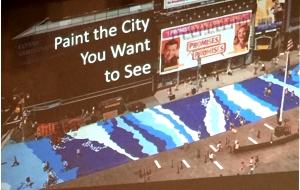 Sadik-Khan reimagined the city and her position, seeing herself as not the Commissioner of Traffic, but of Transportation, a much more holistic approach. She used road paint in DUMBO-(Down Under the Manhattan Bridge Overpass) to create a pedestrian plaza. People immediately used the space. With over 350,000 people using Times Square daily, Sadik-Khan did another pilot project, using street paint and folding beach chairs on a new pedestrian plaza space on the road surface. Sadik-Khan saw success of this temporary space when people talked about the beach chairs, and not the fact that the street was closed. The road paint to create plazas and the beach chairs can be replicated anywhere. The immediate impact in New York City was that sales in adjacent businesses increased 430 per cent with the redesign.
Sadik-Khan reimagined the city and her position, seeing herself as not the Commissioner of Traffic, but of Transportation, a much more holistic approach. She used road paint in DUMBO-(Down Under the Manhattan Bridge Overpass) to create a pedestrian plaza. People immediately used the space. With over 350,000 people using Times Square daily, Sadik-Khan did another pilot project, using street paint and folding beach chairs on a new pedestrian plaza space on the road surface. Sadik-Khan saw success of this temporary space when people talked about the beach chairs, and not the fact that the street was closed. The road paint to create plazas and the beach chairs can be replicated anywhere. The immediate impact in New York City was that sales in adjacent businesses increased 430 per cent with the redesign.
Using artwork and bench programs, and advocating for Vision Zero in transportation related deaths Sadik-Khan increased and enhanced the public realm for pedestrians and bicyclists. The name of her book “Street Fight” comes from her wish to shake up the status quo and see the street differently, not only being space occupied by vehicles. Alan Jacobs the writer of “Great Streets” also talks about the city streets as being the great place for innovation, as over thirty per cent of municipalities are roads, and these spaces can be redesigned to accommodate active transportation and pedestrians. https://mitpress.mit.edu/books/great-streets
I first heard Sadik-Khan speak in 2007 about her work in New York City and I was working with her staff in New York City when the first bike lanes-which were painted a vibrant emerald green-were installed. It was a sublime moment, seeing bicyclists and pedestrians explore the newly created spaces, with bicyclists enjoying separated lanes away from car traffic.
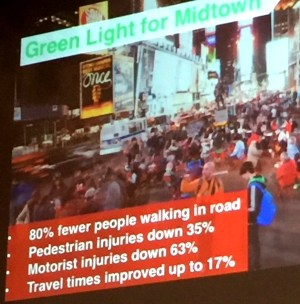 It is evident that Janette Sadik-Khan now perceives that planning and engineering have crested the hill, and are now meshing towards inclusion of pedestrians and bicyclists in 21st century road space and facilities.
It is evident that Janette Sadik-Khan now perceives that planning and engineering have crested the hill, and are now meshing towards inclusion of pedestrians and bicyclists in 21st century road space and facilities.
New York City has shown that creating more space for pedestrians and bicyclists does not lead to gridlock or disaster. Creating demonstration projects to get neighbourhood buy-in is now an accepted practice, and Sadik-Khan has shown this can be achieved in the biggest urban centre, New York City. Sadik-Khan states that it is important to demonstrate how a street can be used differently, test it, ensure that public space is sponsored for others to take care of it, and to look for ways to program it. She is a fan of Ciclovia, the South American Sunday closures of streets for bicyclists.
It is not a matter of IF we should be reimagining our roads for all users but when.
It is the 21st century approach to how to keep our cities and citizens moving in a sustainable and prudent way.
Sandy James
Vancouver Park Board increases access to green space with first pop-up park
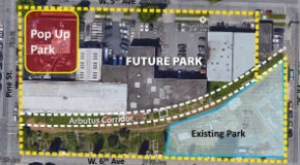 The Vancouver Park Board has approved a new temporary pop-up park in the Burrard Slopes area of Fairview neighbourhood to be completed by the fall.
The Vancouver Park Board has approved a new temporary pop-up park in the Burrard Slopes area of Fairview neighbourhood to be completed by the fall.
A concept plan for the park at the southeast corner of 5th Avenue and Pine Street was approved at a Board meeting last night. The park is located in the same block as the recently completed park at West 6th Avenue and Fir Street. more>>
Vancouver, A Walking Passion Story – The Little Metropolitan Area that Could
Vancouver, A Walking Passion Story – The Little Metropolitan Area that Could
Gordon Price, Director, The City Program, Simon Fraser University






